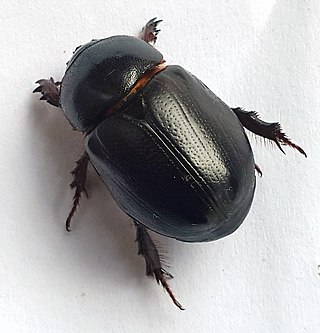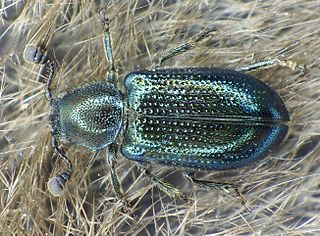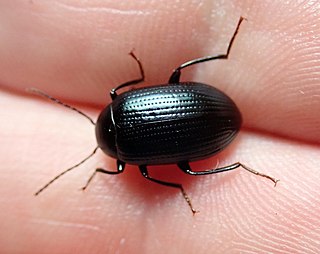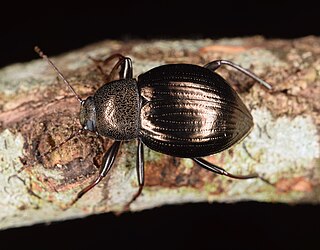
Beetles are insects that form the order Coleoptera, in the superorder Endopterygota. Their front pair of wings are hardened into wing-cases, elytra, distinguishing them from most other insects. The Coleoptera, with about 400,000 described species, is the largest of all orders, constituting almost 40% of described insects and 25% of all known animal species; new species are discovered frequently, with estimates suggesting that there are between 0.9 and 2.1 million total species. Found in almost every habitat except the sea and the polar regions, they interact with their ecosystems in several ways: beetles often feed on plants and fungi, break down animal and plant debris, and eat other invertebrates. Some species are serious agricultural pests, such as the Colorado potato beetle, while others such as Coccinellidae eat aphids, scale insects, thrips, and other plant-sucking insects that damage crops.

Darkling beetle is the common name for members of the beetle family Tenebrionidae. The number of species in the Tenebrionidae is estimated at more than 20,000 and the family is cosmopolitan in distribution.

The Lymexylidae, also known as ship-timber beetles, are a family of wood-boring beetles. Lymexylidae belong to the suborder Polyphaga and are the sole member of the superfamily Lymexyloidea.

Histeroidea is a superfamily of beetles in the infraorder Staphyliniformia.

Zophobas is a genus of beetles in the family Tenebrionidae, the darkling beetles. In Cuba beetles of this genus are known as blind click-beetles.

Tenebrioninae is the largest subfamily of the darkling beetles (Tenebrionidae), containing flour beetles, among others. Tenebrioninae contains more than 20 tribes.

Creophilus maxillosus, the hairy rove beetle, is a species of rove beetle.

The Trictenotomidae are a small family of beetles in the superfamily Tenebrionoidea, containing fifteen species in two genera. Most species are found in the Oriental realm where they live in montane forest habitats. The family is considered, based on larval characters as well as sequence-based studies, to be closely related to the Salpingidae.

Alphitobius diaperinus is a species of beetle in the family Tenebrionidae, the darkling beetles. It is known commonly as the lesser mealworm and the litter beetle. It has a cosmopolitan distribution, occurring nearly worldwide. It is known widely as a pest insect of stored food grain products such as flour, and of poultry-rearing facilities and it is a vector of many kinds of animal pathogens. In larval form, it is an approved novel food in the European Union, and also used as feed.

The tar darkling beetles (Somaticus) are an Afrotropical genus of darkling beetles (Tenebrionidae). Adults are omnivorous scavengers, and the larvae, known as false wireworms, feed on plant roots. The larvae of several species are known to damage maize crops. The adults are matte black with longitudinal ridges on the pronotum and elytra, and may be covered in hairs of different colours.

Heteronychus arator is a species of beetle in the subfamily Dynastinae. It is commonly called African black beetle or black lawn beetle. It is native to Africa and it is an introduced species in Australia, Norfolk Island and the North Island of New Zealand.

Tribolium is a genus of flour beetles in the family Tenebrionidae. They are known by various common names including flour beetles, flour weevils, red weevils and bran bugs.

Asbolus verrucosus(LeConte, 1852), also known as the desert ironclad beetle or blue death feigning beetle, is a species of darkling beetle native to southwestern United States and northwestern Mexico, where it inhabits dry, sandy habitats such as the Sonoran and Mojave Deserts. It is highly adapted to hot environments and is omnivorous, consuming dead insects, fruits, lichen, and other plant matter. When threatened, the beetles are able to feign death. The species is becoming increasingly popular in the pet trade, due to their ease of care, hardiness, and longevity.

Necrobia violacea is a species of beetle in family Cleridae. Cleridae beetles are a predaceous beetle found within forest and woodland environments, and can be associated with stored food products as both pests and predators of other insects.

Lagriinae is a subfamily of long-jointed beetles in the family Tenebrionidae. There are more than 270 genera in Lagriinae, grouped into 11 tribes.

Ceropria induta is a species of darkling beetle native to Asia. It is commonly found in Japan, Korea, southern China to Assam, Sri Lanka and towards islands of Indonesia and the Philippines. There is a sporadic appearance of the species from southern Florida, USA and Macau regions.

Amarygmini is a tribe of darkling beetles in the family Tenebrionidae. There are more than 80 genera in Amarygmini.

Meracantha is a genus of darkling beetles found in North America. It contains one extant species, M. contracta, and also the extinct species M. lacustris.

Rhantus suturalis, commonly known as the supertramp beetle or cosmopolitan diving beetle, is a species of diving beetle (Dytiscidae) with a cosmopolitan distribution.

Amarygmus is a genus of darkling beetles. It is in the tribe Amarygmini and is the oldest genus of the tribe. The genus occurs in Australia, New Guinea, Hawaii, Africa and Eurasia.



















